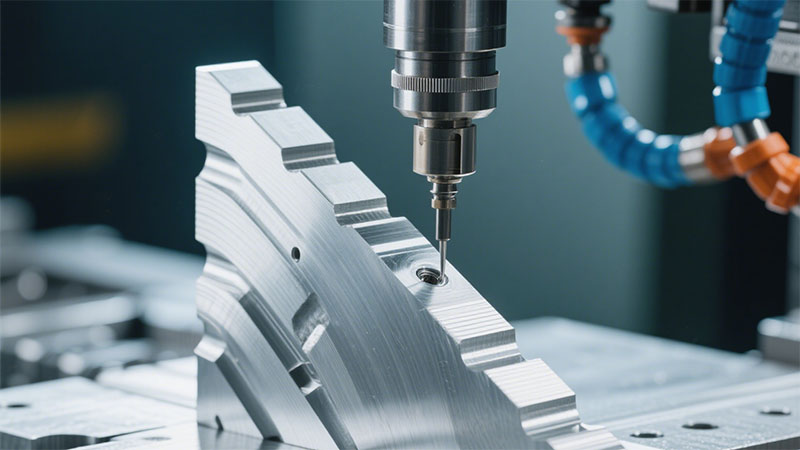In the world of precision manufacturing, the quality of an edge can be just as crucial as the flatness of a surface or the accuracy of a drilled hole. Among the many types of edge treatments, beveling is one of the most commonly used techniques—especially when aesthetic appeal, functional fit, or safety is a concern. This article takes a deeper look at bevel edge machining, exploring what it is, why it matters, and how it is effectively achieved in modern CNC processes.
What Is Bevel Edge Machining?
Bevel edge machining refers to the process of cutting the edge of a workpiece at an angle rather than leaving it at 90 degrees. Unlike chamfering, which is often used to remove only the sharp tip of a corner, beveling typically involves cutting a longer, angled surface that visually and functionally transforms the edge. These beveled edges are most commonly cut at angles ranging from 30 to 60 degrees, depending on design intent and application.
The process is typically applied to both metal and plastic parts, and can be used on the outer perimeter of flat surfaces, around holes, or along complex contours. Beveling not only enhances the appearance of a part but also serves important functional purposes such as improving assembly alignment, reducing stress concentration, or ensuring better bonding and welding in structural applications.
Why Bevel Edges Matter
Beveled edges can influence a wide range of performance factors. In electronic enclosures, for example, beveling helps eliminate sharp corners that might otherwise pose safety risks during handling or assembly. In mechanical components, beveled edges can reduce the risk of stress fractures, particularly at transition points or where frequent contact occurs.
From an assembly standpoint, a beveled edge can significantly improve part alignment and facilitate easy insertion or mating with other components. In decorative or high-visibility products, such as consumer electronics or medical devices, a smooth beveled edge gives a sleek and professional finish, often aligning with brand aesthetics.
In structural applications, such as aerospace or heavy machinery, bevels are sometimes necessary for creating proper weld joints, where the angled edge helps the filler material penetrate more effectively.

How Beveling Is Performed in CNC Machining
In CNC machining, beveling can be performed using specialized cutting tools, angled end mills, or multi-axis milling techniques. The choice of tool and method depends heavily on the part geometry, material type, and desired finish quality.
For straightforward bevels along flat surfaces, a fixed-angle chamfer mill or an angled cutting head is typically used. The CNC program will include precise instructions for the angle and depth of the cut. When beveling around curved surfaces or complex geometries, multi-axis CNC machines (such as 4-axis or 5-axis systems) become essential. These machines allow the tool to approach the edge at various angles, creating consistent bevels even on irregular shapes.
Toolpath strategy also plays an important role. For example, climb milling might be preferred to achieve a better surface finish, while conventional milling could be chosen for specific materials or edge geometries. Coolant flow, feed rates, and spindle speeds must also be adjusted to maintain precision and prevent burr formation, especially when working with soft plastics or tough metals.
Materials and Considerations
Different materials respond differently to bevel edge machining. Metals like aluminum and stainless steel allow for crisp, sharp bevels but may require deburring after the process. Plastics such as acrylic or polycarbonate may melt or chip if cutting parameters are not carefully controlled.
It is also critical to take into account thermal expansion and vibration control, especially for high-precision applications. Even a slight deviation in tool angle or machine calibration can result in inconsistencies that affect part fit or visual appeal.
The selection of tooling is equally important. Carbide tools are commonly used for harder materials, while high-speed steel (HSS) may be sufficient for softer substrates. The tool’s angle must precisely match the intended bevel to ensure consistent results throughout a production batch.
Applications Across Industries
Bevel edge machining finds widespread application across many industries. In aerospace, bevels contribute to weight-saving designs while maintaining structural integrity. In the medical sector, beveled plastic housings make devices easier to clean and handle. The automotive industry uses bevels on both functional and aesthetic components, from dashboard panels to engine parts.
Consumer electronics are another area where beveling plays a vital role—not only in ensuring snug-fitting enclosures but also in delivering the visual appeal that modern devices demand. Even furniture manufacturing and interior design use bevel edge treatments for decorative wooden or composite panels.
Conclusion
Bevel edge machining is far more than a cosmetic procedure; it is a critical feature in many engineered products. By understanding the principles behind beveling, selecting the right tools and methods, and optimizing the machining parameters, manufacturers can greatly enhance product quality, functionality, and efficiency.
As CNC technologies continue to advance, beveling will only become more precise and versatile. Whether you are working on complex aerospace parts or sleek consumer gadgets, mastering bevel edge machining will give you a significant edge—literally and figuratively—in the world of modern manufacturing.



